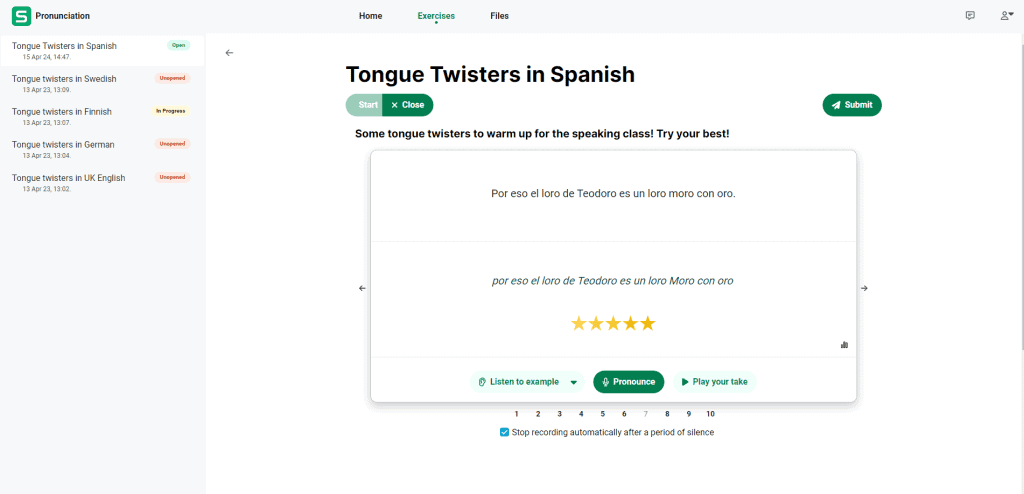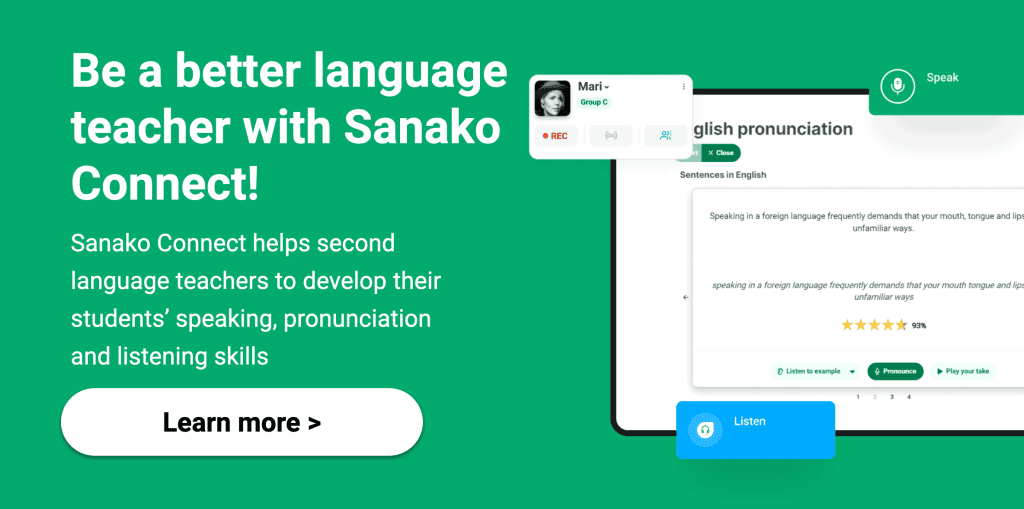As we’ve reiterated on multiple occasions on this blog, speaking is the cornerstone of effective communication and developing this skill in your students is a crucial aspect of language education. It’s vital to give your students as many opportunities as possible to develop their speaking skills and overall language fluency. But assessing the development of their speaking skills is a crucial yet often challenging task.
Unlike written language, which leaves a clear record for evaluation, spoken language takes place in a dynamic mix of real-time classroom interactions. Its ephemeral nature therefore demands a more nuanced approach to assessment – one that captures spoken expression and also provides meaningful feedback to students.
In this blog post, we will therefore explore key considerations for assessing speaking skills, highlight relevant metrics, and delve into the nuanced definition of proficiency in each area. But first of all let’s consider why it’s important to assess students’ speaking skills.
Why assess students’ speaking skills?
It’s crucial to regularly review speaking skills for several compelling reasons.
- It allows educators to track students’ progress over time, identifying areas of strength and weakness. This provides a clear picture of each student’s second language development and helps shape effective learning strategies.
- Regular assessment encourages students to practise their speaking skills, leading to improved fluency and confidence. The feedback they receive helps them identify areas for improvement and motivates them to continue developing their spoken language proficiency.
- Assessing speaking skills prepares students for real-world communication scenarios, empowering them to express themselves clearly and confidently.
- It can also reveal instances of foreign language speaking anxiety, where students may freeze or struggle to communicate effectively due to fear or nervousness.
- Regular assessment encourages students to critically evaluate their own strengths and weaknesses, promoting self-awareness and empowering students to take ownership of their language learning journey.
- Educators can use assessment to identify areas where they need to adapt their teaching methods or provide additional support to help students improve. This continuous feedback loop helps refine teaching practices and promotes more effective learning outcomes.
Why is it difficult for many educators?
Whilst recognising the undoubted benefits of regular speaking skill assessments, many language educators struggle to do them and do not feel confident when conducting them.
Most commonly, educators struggle with the highly qualitative judgments required in such tests. Unlike more objective assessments, such as grammar-translation or multiple-choice tests, evaluating speaking skills involves various factors, including pronunciation, fluency, and cultural appropriateness, which can be open to interpretation.
Unlike more established and standardised assessments for reading or writing, speaking assessments often lack universally accepted tools and rubrics. This can make it challenging to ensure consistency and fairness across different classes or institutions.
Conducting speaking assessments can also be very time-consuming, especially in large classes. Listening to each student individually, providing constructive feedback, and documenting results can therefore be a significant investment of time and effort. This, of course, assumes that every educational setting has the audio recording equipment needed to conduct comprehensive speaking assessments available in the first place!
Assessing speaking skills can also be particularly challenging for teachers who are not native speakers of the target language. They may not fully grasp the nuances of pronunciation, intonation, and cultural context, making it difficult to make accurate and consistent judgments of their students.
Furthermore, educators may also experience challenges operating in classrooms with diverse student proficiency levels. This can make it difficult to balance the need for individualised assessment with the constraints of whole class work and varying student comfort levels in speaking activities. As referenced above, some students may also experience anxiety or shyness during speaking assessments, which can affect their performance. Teachers therefore need to create a supportive and comfortable speaking environment to encourage students to showcase their true speaking abilities.
To address these challenges, the use of standardised rubrics and incorporating digital technologies for assessment can be hugely beneficial. Further detail on both of these points follows below.
What should a speaking assessment actually review?
When considering the above challenges, Sanako wanted to provide some suggestions of the key elements to assess when measuring your students’ speaking skills. Whilst these may be different in your institution, most speaking assessments tend to focus on the following five elements.
We have included a definition of what “good” looks like for all of these below. A more detailed rubric to evaluate speaking assessment, featuring criteria for excellent and inadequate performance can be downloaded from this link: Rubric Template for Speaking Assessment.
1. Pronunciation and intonation
Assessing students in this area involves gauging their ability to articulate sounds accurately and to convey the rhythm and pitch of the language. A clear, intelligible pronunciation is essential for effective communication. Educators should focus on students’ mastery of phonetics, ensuring they can replicate the nuanced sounds of the target language.
Definition of “Good”: Pronunciation is mostly accurate, with occasional minor errors that do not hinder communication. Intonation is generally natural.
2. Vocabulary and lexical range
A rich vocabulary enhances the depth and nuance of expression. When assessing students’ speaking skills, consider their lexical range — the variety and complexity of words they incorporate into their speech. Encourage the use of diverse vocabulary to convey thoughts and ideas accurately.
Definition of “Good”: Utilises a good range of vocabulary, incorporating both common and some specialised terms.
3. Fluency and cohesion
Fluency is the bridge that connects students’ thoughts seamlessly. Assessing fluency involves evaluating how smoothly students express themselves and maintain a coherent flow in conversation. Educators should also pay attention to the cohesive devices students use to link ideas, ensuring a logical progression in their speech.
Definition of “Good”: Generally fluent, with some minor disruptions. Cohesive devices contribute to overall coherence.
4. Grammar and syntax
The backbone of any language lies in its grammatical structures. Assessing grammar and syntax involves scrutinising students’ adherence to language rules, including verb conjugation, sentence structure, and grammatical accuracy.
Definition of “Good”: Generally accurate grammar with occasional minor errors. Sentence structures are varied.
5. Communication strategies
Language is not just about words but also about conveying ideas effectively. Assessing communication strategies involves evaluating how well students employ various techniques, such as paraphrasing, clarification, and circumlocution, to express themselves when faced with linguistic challenges.
Definition of “Good”: Demonstrates proficiency in using strategies to navigate communication challenges.

How can Sanako help assess your students’ speaking skills?
With customers in 114 countries and language teaching products in use in over 50,000 classrooms globally, Sanako has significant experience in improving students’ learning outcomes, particularly their speaking skills. There’s also clear evidence that Sanako’s range of digital solutions can significantly increase students’ speaking time in an average lesson.
Sanako Connect language teaching platform is perfectly suited for the task of developing students’ speaking skills and to increase the practice time. Educators can easily divide students into pairs or small groups for live conversation practice and role-play activities. Each group of students can talk simultaneously via Connect without distracting other groups. Teachers can listen in or talk with different groups to assist as required. All of these individual group or pair conversations can also be easily recorded and reviewed for feedback after the event, rather than interrupting live conversations.

Educators can use Sanako Connect to create and share a wide variety of speaking tasks with students. These include automated pronunciation grading tasks, model imitation, oral assessments, online tests, or fill-in-the-blanks exercises – all of which can be created by educators in minutes. Importantly, such exercises can be saved, edited and reused with different classes and students as required. This helps reduce teachers workload and save time on lesson planning and preparation.
With Sanako Connect, conducting live whole-class simultaneous speaking assessments is easy and fast using the teacher-controlled speaking activity. Teachers can provide speaking prompts during a live class and activate student recorders to collect individual responses. Additionally, Connect enables teachers to utilise various stimulus materials such as audio clips, videos, or any multimedia content. Similarly, Connect’s flexible content editor facilitates the swift creation of asynchronous speaking assessments, offering dedicated settings for self-paced examinations. These settings include establishing the maximum length for student recordings or allowing them to record only once per assignment.
If you’d like to find out more about how Sanako’s dedicated language teaching software could help you to assess your students’ speaking skills, click here or the banner below to learn more!

